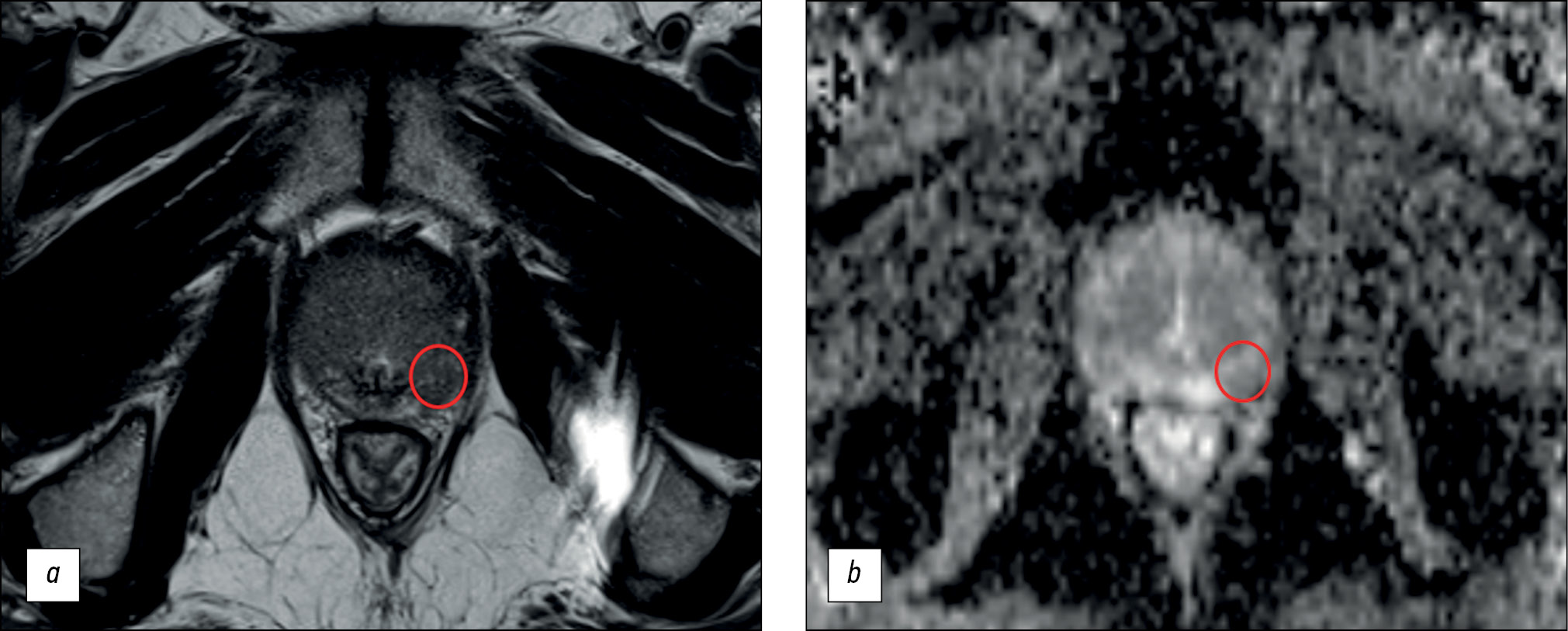比较具有不同经验的放射科医生检测前列腺癌的多参数和双参数磁共振成像协议
- 作者: Vasilev Y.A.1, Omelyanskaya O.V.1, Vladzymyrskyy A.V.1, Gelezhe P.B.1,2, Reshetnikov R.V.1, Gonchar A.P.1, Blokhin I.A.1, Abdullin I.I.1, Kieva I.N.3
-
隶属关系:
- Moscow Center for Diagnostics and Telemedicine
- Joint stock company “European Medical Center”
- Speransky Children’s Hospital
- 期: 卷 4, 编号 4 (2023)
- 页面: 455-466
- 栏目: 原创性科研成果
- URL: https://journals.rcsi.science/DD/article/view/262947
- DOI: https://doi.org/10.17816/DD322816
- ID: 262947
如何引用文章
详细
论证。磁共振成像(MRI)允许发现有临床意义的前列腺癌、诊断囊外扩展并对癌症发展进行分期。如果扫描协议仅包括T2加权和弥散加权图像,只要检查的诊断准确度保持较高水平,其就能很好地替代多参数磁共振成像。在最近的研究中,双参数(bpMRI)和多参 数(mpMRI)磁共振成像在检测前列腺癌方面的诊断准确度差别不大。
该研究的目的是比较bpMRI和mpMRI在检测有临床意义的前列腺癌方面的诊断准确度。比较是根据PI-RADS v2.1系统进行的,以MRI引导下的多点活检为金标准。
材料和方法。本研究是一项回顾性研究。我们初步处理了126名患者的病史。纳入标准 为:(1)符合PI-RADS 2.1标准的mpMRI;(2)血液中游离和结合前列腺特异性抗原水平的临床信息;(3)前列腺多点活检。磁共振成像与活检之间的时间间隔不超过14天。研究由三名放射科医生进行。医生的工作经验分别为2年以下、2至5年和5年以上。这些医 生(研究人员)独立评估前列腺bpmRI 是否存在病灶。2周后,研究人员(这些医生)对前列腺mpMRI 数据集进行了评估。从PI-RADS 3类别开始,将发现的每个病灶与多点融合活检结果进行了比较。活检结果显示为Gleason评分值的总和。Gleason评分7分或更高被认为是有临床意义的活检结果。磁共振成像显示的肿瘤灶被认为是符合PI-RADS标准4和5的结果。
结果。前列腺磁共振成像检测病灶的最佳灵敏度和特异度分别为62.5%和74.6%。诊断准确率最高达到70.1%。由工作经验少于2年和多于5年的放射科医生进行mpMRI解读时,前列腺病灶检测的特异度更高。
结论。前列腺的bpMRI和mpMRI都显示出不理想的诊断准确度。随着放射科医生经验的增加,该方法的灵敏度和特异度有提高的趋势。与多参数协议相比,双参数前列腺扫描协议具有明显的经济优势。这种优势是不需要造影剂和消耗品的费用,并大大减少磁共振扫描仪的装载时间。不过,使用这种方法可能会降低诊断准确度。
作者简介
Yuriy A. Vasilev
Moscow Center for Diagnostics and Telemedicine
Email: npcmr@zdrav.mos.ru
ORCID iD: 0000-0002-0208-5218
SPIN 代码: 4458-5608
MD, Cand. Sci. (Med)
俄罗斯联邦, MoscowOlga V. Omelyanskaya
Moscow Center for Diagnostics and Telemedicine
Email: o.omelyanskaya@npcmr.ru
ORCID iD: 0000-0002-0245-4431
SPIN 代码: 8948-6152
俄罗斯联邦, Moscow
Anton V. Vladzymyrskyy
Moscow Center for Diagnostics and Telemedicine
Email: npcmr@zdrav.mos.ru
ORCID iD: 0000-0002-2990-7736
SPIN 代码: 3602-7120
MD, Dr. Sci. (Med), Professor
俄罗斯联邦, MoscowPavel B. Gelezhe
Moscow Center for Diagnostics and Telemedicine; Joint stock company “European Medical Center”
编辑信件的主要联系方式.
Email: gelezhe.pavel@gmail.com
ORCID iD: 0000-0003-1072-2202
SPIN 代码: 4841-3234
俄罗斯联邦, Moscow; Moscow
Roman V. Reshetnikov
Moscow Center for Diagnostics and Telemedicine
Email: reshetnikov@fbb.msu.ru
ORCID iD: 0000-0002-9661-0254
SPIN 代码: 8592-0558
俄罗斯联邦, Moscow
Anna P. Gonchar
Moscow Center for Diagnostics and Telemedicine
Email: a.gonchar@npcmr.ru
ORCID iD: 0000-0001-5161-6540
SPIN 代码: 3513-9531
俄罗斯联邦, Moscow
Ivan A. Blokhin
Moscow Center for Diagnostics and Telemedicine
Email: i.blokhin@npcmr.ru
ORCID iD: 0000-0002-2681-9378
SPIN 代码: 3306-1387
俄罗斯联邦, Moscow
Iskander I. Abdullin
Moscow Center for Diagnostics and Telemedicine
Email: iabdullin@emcmos.ru
ORCID iD: 0000-0003-1138-0822
SPIN 代码: 6560-5219
俄罗斯联邦, Moscow
Irina N. Kieva
Speransky Children’s Hospital
Email: kieva.irina@gmail.com
ORCID iD: 0000-0002-4060-5966
SPIN 代码: 2279-9141
俄罗斯联邦, Moscow
参考
- Turkbey B, Rosenkrantz AB, Haider MA, et al. Prostate imaging reporting and data system version 2.1: 2019 Update of prostate imaging reporting and data system version 2. Eur Urol. 2019;76(3):340–351. doi: 10.1016/j.eururo.2019.02.0331
- Bjurlin MA, Carroll PR, Eggener S, et al. Update of the standard operating procedure on the use of multiparametric magnetic resonance imaging for the diagnosis, staging and management of prostate cancer. J Urol. 2020;203(4):706–712. doi: 10.1097/JU.0000000000000617
- Rouvière O, Puech P, Renard-Penna R, et al. Use of prostate systematic and targeted biopsy on the basis of multiparametric MRI in biopsy-naive patients (MRI-FIRST): A prospective, multicentre, paired diagnostic study. Lancet Oncology. 2019;20(1):100–109. doi: 10.1016/S1470-2045(18)30569-2
- Boesen L, Thomsen FB, Nørgaard N, et al. A predictive model based on biparametric magnetic resonance imaging and clinical parameters for improved risk assessment and selection of biopsy-naïve men for prostate biopsies. Prostate Cancer Prostatic Dis. 2019;22(4):609–616. doi: 10.1038/s41391-019-0149-y
- Tamada T, Kido A, Yamamoto A, et al. Comparison of biparametric and multiparametric MRI for clinically significant prostate cancer detection with PI-RADS Version 2.1. J Magnetic Resonance Imaging. 2021;53(1):283–291. doi: 10.1002/jmri.27283
- Wallström J, Geterud K, Kohestani K, et al. Bi- or multiparametric MRI in a sequential screening program for prostate cancer with PSA followed by MRI? Results from the Göteborg prostate cancer screening 2 trial. Eur Radiol. 2021;31(11):8692–8702. doi: 10.1007/s00330-021-07907-9
- Kuhl CK, Bruhn R, Krämer N, et al. Abbreviated biparametric prostate MR imaging in men with elevated prostate-specific antigen. Radiology. 2017;285(2):493–505. doi: 10.1148/radiol.2017170129
- Abuladze LR, Semenov DS, Panina OV, Vasil AA. Optimized protocol of biparametric magnetic resonance imaging for prostate. Digital Diagnostics. 2022;3(3):166–177. doi: 10.17816/DD108484
- Schoots IG, Barentsz JO, Bittencourt LK, et al. PI-RADS committee position on MRI without contrast medium in biopsy-naive men with suspected prostate cancer: Narrative review. Am J Roentgenol. 2021;216(1):3–19. doi: 10.2214/AJR.20.24268
- Gleason DF. Classification of prostatic carcinomas. Cancer Chemother Rep. 1966;50(3):125–128.
- Zawaideh JP, Sala E, Shaida N, et al. Diagnostic accuracy of biparametric versus multiparametric prostate MRI: Assessment of contrast benefit in clinical practice. Eur Radiol. 2020;30(7):4039–4049. doi: 10.1007/s00330-020-06782-0
- Kang Z, Min X, Weinreb J, et al. Abbreviated biparametric versus standard multiparametric MRI for diagnosis of prostate cancer: A systematic review and meta-analysis. Am J Roentgenol. 2019;212(2):357–365. doi: 10.2214/AJR.18.20103
- Niu XK, Chen XH, Chen ZF, et al. Diagnostic performance of biparametric MRI for detection of prostate cancer: A systematic review and meta-analysis. Am J Roentgenol. 2018;211(2):369–378. doi: 10.2214/AJR.17.18946
- Ahmed HU, El-Shater Bosaily A, Brown LC, et al. Diagnostic accuracy of multi-parametric MRI and TRUS biopsy in prostate cancer (PROMIS): A paired validating confirmatory study. Lancet. 2017;389(10071):815–822. doi: 10.1016/S0140-6736(16)32401-1
- McDonald RJ, Levine D, Weinreb J, et al. Gadolinium retention: A research roadmap from the 2018 NIH/ACR/RSNA workshop on gadolinium chelates. Radiology. 2018;289(2):517–534. doi: 10.1148/radiol.2018181151
- Ploussard G, Epstein JI, Montironi R, et al. The contemporary concept of significant versus insignificant prostate cancer. Eur Urol. 2011;60(2):291–303. doi: 10.1016/j.eururo.2011.05.006
- Loeb S, Vellekoop A, Ahmed HU, et al. Systematic review of complications of prostate biopsy. Eur Urol. 2013;64(6):876–892. doi: 10.1016/j.eururo.2013.05.049
- Campli ED, Pizzi DA, Seccia B, et al. Diagnostic accuracy of biparametric vs multiparametric MRI in clinically significant prostate cancer: Comparison between readers with different experience. Eur J Radiol. 2018;(101):17–23. doi: 10.1016/j.ejrad.2018.01.028
- Gatti M, Faletti R, Calleris G, et al. Prostate cancer detection with biparametric magnetic resonance imaging (bpMRI) by readers with different experience: Performance and comparison with multiparametric (mpMRI). Abdominal Radiol (New York). 2019;44(5):1883–1893. doi: 10.1007/s00261-019-01934-3
补充文件











